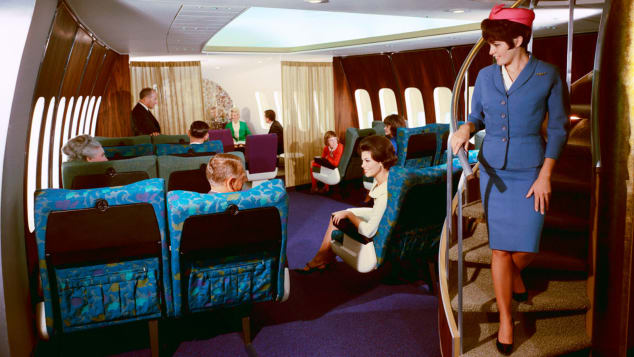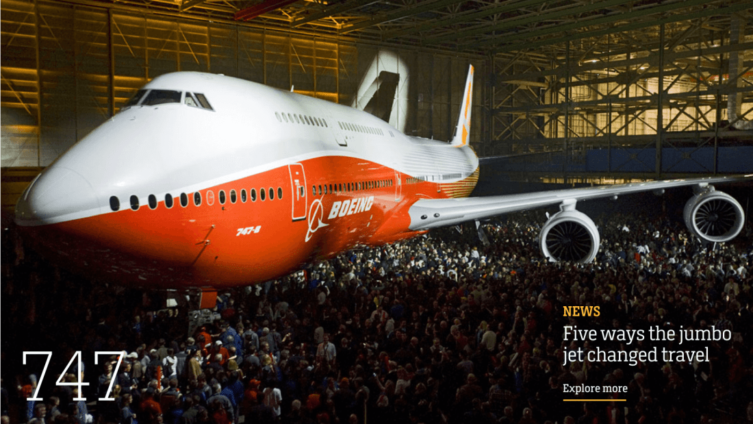With British Airways retiring its fleet of Boeing 747s four years ahead of schedule, the final flying days of the planet's most recognizable jetliner are approaching sooner than expected.
"It is unlikely our magnificent 'queen of the skies' will ever operate commercial services for British Airways again due to the downturn in travel caused by the Covid-19 global pandemic," said the British flag carrier.
The first Boeing 747 made its maiden flight on February 9, 1969, a year before entering service with the fondly remembered airline Pan American World Airways.
It quickly became a passenger favorite.
It's doubled as a flying White House as Air Force One, as well as being the setting for many a Hollywood airborne adventure.
There are only around 170 of the passenger version of the "queen of the skies" still in fleets around the world, and fewer than 30 currently in use, according to Cirium Fleets, a research firm that tracks commercial jets.
Many airlines have been replacing their passenger 747s with larger, more advanced, and more efficient twin-engine planes.
The most recent version of "The Queen of the Skies" is the 747-8 Intercontinental, with new wings, engines, and technologies unimaginable to the designers and pilots of the original 747.
While its unique silhouette will still be around for a while yet -- albeit in fewer and fewer numbers -- there's little doubt that the "Queen's" impact on aviation is as big as its size.
The first wide-body
The 747 ushered in the era of the twin-aisle, wide-body passenger plane. But had it been up to Pan Am's founder, Juan Trippe, the celebrated jet might have been a double-deck version of the single-aisle Boeing 707.
Trippe pushed the plane's designers to come up with a double-decker, a shape that Boeing engineer Joe Sutter, known as the "father of the 747," called a "turkey."
It took a Boeing executive's initiative in a meeting in a Pan Am boardroom to change Trippe's mind. The dimensions of the room were exactly the same as the proposed wide-body 747's width and height, and Pan Am was impressed.
The interior of the 747 was developed in association with the Seattle-based firm Teague, Boeing's long-time cabin design partner.
It was the first plane to have almost vertical sidewalls and a high ceiling, giving passengers a feeling of space and openness.
Instead of a long, thin tube, the cabin was split up into "rooms," with galleys and lavatories installed as dividers.It's a shape that has defined long-haul travel for nearly half a century.

Boeing
Up-sized airports
The 747's dimensions were huge compared to the 707s and Douglas DC-8s that were the mainstay of airlines' international fleets in the 1960s.
With hundreds of passengers arriving and departing on every jumbo jet, airports had to quickly adapt, with expanded boarding lounges, check-in counters, and terminals.
Every international airline wanted to have the prestige of flying a 747, meaning that existing customs and immigration areas were soon overwhelmed with multiple, simultaneous arrivals of the big plane.
Ground-support equipment had to grow, too. Aircraft tugs got a lot bigger, to handle the 747's prodigious weight of over 750,000 pounds. Catering trucks were modified to reach the cabin doors far above the ramp, and refuelling tankers now had to stretch to reach the underside of the massive wings.
Fabulous freight-hauler
The 747 was designed at a time when the airline industry expected the supersonic transport -- SST for short -- to be the aircraft of the future.
The world's first supersonic transport aircraft, the Soviet-designed Tupolev Tu-144, had made its maiden flight in 1968 and the Anglo-French Concorde took to the air two months later.
Experts in the 1960s predicted that the 747 would have a short lifetime as a passenger jet, eventually giving way to aircraft traveling at multiple times the speed of sound. So the 747's designers tried to future-proof the jumbo by engineering it to carrying cargo.
The main deck of the 747 was sized about 20 feet wide, to handle two standard cargo containers. To make loading easier, the nose of the cargo model of the 747 opened and pivoted upwards.
That meant that the cockpit had to be located above the main deck, giving the Queen its distinctive hump just behind the flight deck. What was originally envisioned as a crew rest area in that space became the jet's most renowned feature, the passenger lounge. Only in later versions did that upper deck get stretched to accommodate a large seating area.As it turned out, the Boeing SST project -- the 2707 -- was canceled in 1971, the Tupolev Tu-144 was permanently grounded after only 55 scheduled flights, and Concorde made its final flight nearly 15 years ago.As for the hardy 747, more than 1,500 of them have been manufactured over the past half-century.The last Boeing 747 commercial passenger jet to be delivered was in July 2017 -- a jumbo for Korean Air Lines -- and in January 2018 US passenger operations ended when Delta Air Lines Flight 9771 touched down in a jetliner boneyard in Marana, Arizona.Transatlantic travel on the jumbo jet isn't over, though. Lufthansa has 10 747-400s and 19 747-8s in its fleet. A spokesperson said the German flag-carrier continues to operate the aircraft on routes in North America, Asia and other long-haul destinations.
The new big fan
New airplanes and new engines are created at the same time. New aircraft designers might seek to consume less fuel, generate more power, and take advantage of lighter-weight designs from engine developers.
The 747 needed a huge jump in engine power and efficiency to get the massive plane in the air, and make money for the airlines. Pratt & Whitney changed the shape of jet engines forever with their JT9D turbofans for the 747. The engine differed from earlier power plants by having a huge fan at the front.
An enormous amount of air is forced into the engine, but only a small portion goes into the engine's core where it is compressed, mixed with fuel and ignited to drive the turbine. The internal turbine spins the huge fan, pushing the jet forward.
With most of the air flow directed around -- rather than through -- the core of the engine, it was the first "high-bypass" turbofan of the jet age.
The design makes the engine quieter, more powerful, and with better fuel efficiency. And instead of the scream of earlier generation jets, the 747 "buzzed" when it took off.
The 747 might have been the first, but now every passenger jet is powered by an incredibly reliable and sophisticated high-bypass turbofan engine.
The real game-changer?
The 747 went into service in the early 1970s, at a time of major societal change. It drove exponential growth in air travel, tourism, and connections between people around the world. In its first year, a fully-loaded 747 cut the cost of flying a passenger by half. Flying became instantly more accessible.
But maybe the award for the biggest change in air travel should go to the 747's older sibling, the 707. That smooth-flying, jet-powered pioneer was a quantum leap from the "piston-pounders" that preceded it. It connected continents in mere hours and showed the world the power of jet travel.B
rien Wygle, the co-pilot on the 747's first flight, and Boeing's former vice president of flight operations, certainly thinks so.
"The shorter flight times, the higher altitudes, the better pressurisation -- a lot of things we brought out with the 707 were revolutionary," he tells CNN Travel. "The 747 furthered that same direction, but you can't ignore what the 707 did."
"But the 747 was a remarkable airplane, and I loved it."
Latest Stories
-
‘Expired’ rice scandal: FDA confirms rice was safe for consumption
31 seconds -
Many women have experienced intimate partner violence – Angela Dwamena Aboagye
21 mins -
Power challenges persist due to government’s mismanagement of revenues – Okudzeto Ablakwa
1 hour -
Jordan Ayew injury not as bad as feared – Leicester City boss
1 hour -
Stonebwoy heads to North America for UP & RUNNIN6 tour
1 hour -
FDA explains extension of best-before date for ‘expired’ rice
1 hour -
Rebecca Akufo-Addo, Mahama storm Akuapem North as NPP NDC slugs it out
1 hour -
Fatawu’s injury a big blow for us – Leicester City manager
1 hour -
No MC has influenced pop culture in 2024 more than me – Portfolio
2 hours -
Kpando NCCE holds dialogue for Parliamentary Candidates
2 hours -
Bawumia solicits support of CSOs to tackle ‘entrenched interests’ in corruption fight
2 hours -
I’m looking forward to working with CSOs, research institutions; they have a lot to offer – Bawumia
2 hours -
The former illegal miner who became valedictorian: Eliasu Yahaya Bansi’s KNUST journey
2 hours -
Prof Opoku-Agyemang slams gov’t over supply of ‘expired’ rice to Senior High Schools
2 hours -
‘Expired’ rice: Lamens Investments GH¢100k fine was for regulatory violations – FDA clarifies
2 hours

